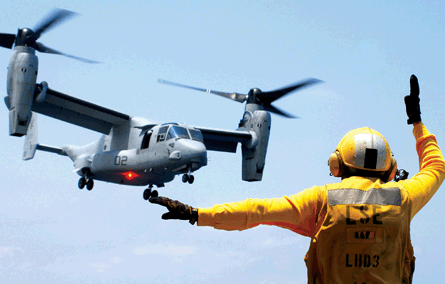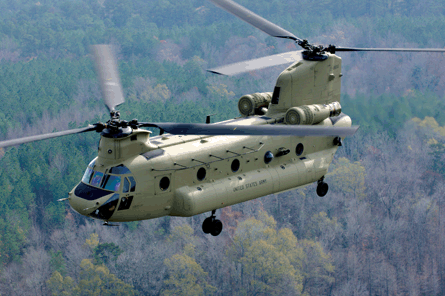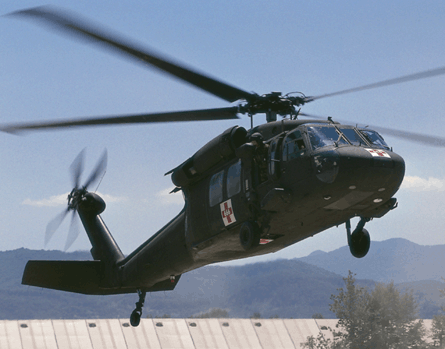Although global demand has declined since the Cold War, and although some new helicopter acquisition programmes have run into real difficulties, many air forces are investing heavily in improving their helicopter capabilities.
The threat posed by Islamist terrorism has led to an increased demand for helicopters for use in internal security and law enforcement roles, sometimes flown by military units, sometimes by parapublic operators.
For the UK, USA and other nations, the demand for helicopters has been driven by the campaigns in Iraq and Afghanistan, where the threat from improvised explosive devices (IED) has led to a growing shift from road to air transport for the routine movement of troops, and where the helicopter support of special operations forces has been pivotal. Helicopters have also provided a life-and-death medical evacuation capability.
 |
|---|
© USAF |
The media focus on shortages of helicopter capacity in Afghanistan have fuelled public concern that there are insufficient aircraft to ensure the safety of their troops, and this has led to pressure for specific helicopter acquisition programmes in some coalition countries, most notably in the UK and USA.
But market growth will not solely be based on Afghan requirements, and Asia and the Middle East are expected to be responsible for significant growth in the military helicopter market in 2010 and beyond, and this growth will help parts of the industry to ride out the reduction in civilian helicopter orders.
Eurocopter, for example, suffered a marked decrease in commercial helicopter orders in 2009, but the increase in demand for military rotorcraft allowed the company to record its second-highest annual sales tally.
In its annual survey of the international rotorcraft market Rolls-Royce predicted that the world's helicopter manufacturers would deliver around 6,100 military helicopters over the next decade, representing just over one-third of the total number of 16,400 helicopters delivered in the same period.
These military deliveries will be worth an estimated $108 billion of the $146 billion total, and 2010 alone will account for spending on military rotorcraft worth a staggering $15.3 billion.
Much of the activity will be in the medium/heavy segment of the military helicopter market, which is defined as a helicopter with a gross weight of 6,800kg (15,000lb), or more, with deliveries of 4,319 medium/heavy helicopters (worth an estimated $92.3 billion) predicted during the 10-year period. Deliveries are expected to grow rapidly in the first half of the decade, from 391 helicopters in 2010, to 500 in 2014, before dipping to an annual rate of 376 helicopters by 2019, as high-volume procurement programmes from the beginning of the decade start to tail off.
But all military helicopter classes will share in the growth to some extent, and significant utility, attack, intelligence, surveillance and reconnaissance/scout and maritime helicopter orders are expected. But while many air arms are expanding their helicopter operations, there has also been a great expansion in the use of contractor-owned helicopters, in what were once viewed as core military roles.
Helicopter pilot and aircrew training has been widely civilianised, and last year the US Department of Defense was forced to search for a civilian contractor to provide cargo delivery services in Afghanistan to augment its hard-pressed army and air force helicopter assets in-theatre.
 |
|---|
© Sikorsky |
The normal requirement to run a full and open competition was set aside, so urgent was the requirement to provide this critical capability.
In the UK, the "gold standard" search and rescue service, one of the largest contracts provided by a mix of military and civilian helicopters, is to be replaced from 2012 by a service provided by preferred bidder Soteria, which hopes to sign a £6 billion, 25-year private finance initiative contract this year.
The existing mix of civil Sikorsky S-92s and AgustaWestland AW139s and Royal Air Force and Royal Navy Westland Sea Kings is to be replaced by a smaller fleet of S-92s. Only 66 military aircrew are being retained under the new system to ensure that a percentage of RAF and RN helicopter crews are SAR trained and experienced to allow them to undertake deployed military SAR operations.
The USA remains the key market for military rotorcraft, and Afghanistan continues to drive the shape of US helicopter procurement.
Boeing enjoys a full orderbook for its Chinook, with the new CH-47F Improved Cargo Helicopter, which has a modernised airframe, T55-GA-714A engines and an advanced digital flight control system. It is re-equipping army units and winning export orders (initially from the Netherlands and Australia). The dedicated MH-47G is going to the Special Operations community.
 |
|---|
© US Army |
The company's rotorcraft portfolio also includes the Apache, now undergoing a comprehensive Block III upgrade, and the AH-6i, already being aggressively marketed to export customers and a potential candidate to meet nascent US Army requirements for an armed reconnaissance helicopter following the failure of the Bell 407 ARH.
Boeing is also teamed with Bell on the V-22 Osprey Tiltrotor, production of which continues, as the type adds to its combat record in Afghanistan.
Sikorsky is also enjoying strong demand for its military helicopters, with significant multi-year contracts from the US Military for the UH-60 Black Hawk and MH-60 Sea Hawk, and with continuing demand for the type from export customers.
This demand has led to the development of the S-70i "International Black Hawk" a less expensive multi-mission variant produced by Sikorsky's global partners and to be delivered from Sikorsky's newly acquired PZL Mielec plant in Poland.
Sikorsky is also energetically marketing an Armed Black Hawk or "BattleHawk", fitted with an advanced cockpit, helmet-mounted sighting systems, an undernose 20mm gun and a chin-mounted electro-optical turret developed in association with Israel's Elbit, as well as an optionally manned Black Hawk that could be flown manned (with one or two pilots) or as an autonomous unmanned vehicle.
The bigger S-92 is already in service with the Saudi ministry of the interior in the internal security role, and the type has also secured a niche as VIP transport. Canada has now received the first of its militarised, ASW-configured S-92s (locally designated as the CH-148 Cyclone), albeit to an interim standard, and the type is expected to become fully operational in 2013.
 |
|---|
© USAF |
Sikorsky is also developing a next-generation version of its triple-engined heavyweight, CH-53E Super Stallion. The new CH-53K heavylift helicopter, which is due to fly in November 2011, has new General Electric GE38-1B engines, new composite main rotor blades, an all-new glass cockpit and a wider cabin, and 227 are on order to re-equip USMC heavy lift helicopter squadrons.
Military helicopter sales accounted for 39% of Bell's revenue in 2009, with its share of the Bell/Boeing V-22 Osprey augmenting the company's own AH-1Z and UH-1Y programmes.
European manufacturers are increasingly making inroads into the US defence market. Although the effort by AgustaWestland and Lockheed Martin to meet the VXX "Marine One" Presidential Helicopter requirement using the AW101/VH-71 helicopter stalled, Boeing has now secured the rights to use AgustaWestland intellectual property, data and production rights to integrate the same basic AW101 into a Boeing product to meet the same VXX programme requirement.
Meanwhile, Eurocopter has built on its initial success with the Dauphin (used, as the HH-65, by the US Coast Guard since 1979) by successfully offering the EC145 to meet the US Army's Light Utility Helicopter (LUH) requirement. Some 322 helicopters are being procured by the US Army as the UH-72A Lakota for Homeland Security, medevac, logistics support and other missions, and to support the army's test and training centres. Five more are being acquired for the US Naval Test Pilot School.
The company, teamed with Lockheed, is offering an armed version of the EC145, known as the Armed Scout 645 or AAS-72, to meet the US Army's requirement for an armed scout helicopter to replace the OH-58 Kiowa.
Outside the USA, big helicopter orders tend to be numbered in tens, rather than hundreds, making the UK's plan to acquire 22 new Chinooks (plus two attrition replacements) a relatively big deal - always assuming that the plan survives the incoming coalition government's promised defence review, and new Prime Minister David Cameron's hope to see UK troops withdrawn from Afghanistan by 2015. The multirole Lynx Wildcat military helicopter, which made its maiden flight at Yeovil on 12 November 2009, is planned as a 62-aircraft programme, with the first due to enter service in 2014.
Elsewhere, the multinational NH90 programme continues to make progress, though some early customers have experienced problems, and orders are building only relatively slowly, although the total programme is large, thanks to the large number of customers.
As with civil helicopters, one of the most important and fastest growing markets for military helicopters is in the Far East. India and Indonesia are being targeted by Boeing as possible markets for the Chinook, with India also having been offered the AH-64D Apache attack helicopter. Sikorsky is also targeting the Indian market, and has established a joint venture with Tata Advanced Systems to manufacture aerospace components in India, while also marketing various helicopter types to the Indian forces. Eurocopter is offering the AS550 to meet an Indian requirement for a scout helicopter, while AgustaWestland has signed a contract to supply 12 AW101 helicopters to the Indian air force.
With no end in sight for the campaign in Afghanistan, and with a steady demand for new helicopters continuing in Asia and the Middle East, the boom in military rotorcraft looks set to continue, and the prospects for manufacturers and upgrade providers look promising. Advanced technologies are making good progress, and many believe that the foundations are now being laid for a radical new generation of military rotorcraft, whose new capabilities will allow an expansion into new roles.
- All the latest news, video and images from the 2010 Farnborough air show - New this year, live streaming video of each day's flying display
Source: Flight Daily News























